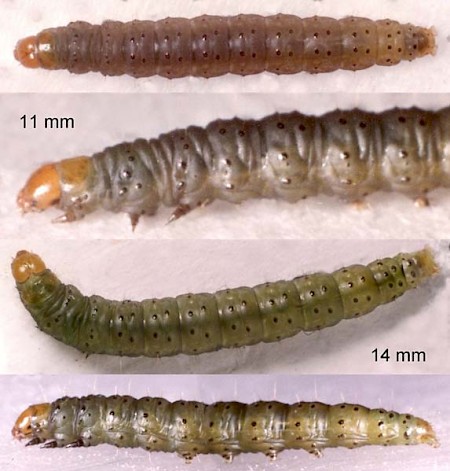
32.032 BF713
Agonopterix angelicella
(Hübner, [1813])
Wingspan 18-19 mm.
A relatively common species throughout most of Britain, where the adults are found on the wing between August and September.
The larvae feed, often gregariously, among spun leaves or shoots of angelica (Angelica) and hogweed (Heracleum). They can be found in May and June, the large spinnings quite conspicuous.
The adults rest in a distinctive Depressariidae fashion, with one forewing almost completely overlapping the other.
- Larva: (description Ian F. Smith):
Foodplants: May - June on Heracleum sphondylium, Angelica sylvestris and Peucedanum palustre. Often several larvae in one large untidy leaf spinning.
Early instar (description MBGBI)
Head: black
Prothoracic shield: black
Intermediate instars
Length: 11 mm and 14 mm described.
Head: Amber. Frons and posterior of epicranial spheres thinly edged black. Postero-lateral mark black. Black stemmata joined by blackish curved band.
Prothoracic shield: Amber transparent. Appears strongly amber when head withdrawn beneath it, but green or grey when head extended.
Thoracic legs: Base concolorous with body. Femur, tibia, tarsus black (14 mm), or brownish ringed black (11 mm).
Body: Darker dorsally. Grey (11 mm) or dull green (14 mm).
Spiracles: Black peritreme
Pinacula: Black
Setae: Translucent. Tinted amber basally.
Anal plate: Amber transparent with indistinct darker spots.
Prolegs: Planta whitish distally, black basally. Anal prolegs have large amber lateral sclerites. Crochets reddish brown.
Late instar (description MBGBI)
Head: Amber.
Prothoracic shield: Green with blackish lateral spot.
Thoracic legs: Yellowish, ringed dark brown.
Body: Dull green.
Pinacula: Black
Anal plate: Usually concolorous with body and with variable blackish markings.

 UKMoths
UKMoths 

